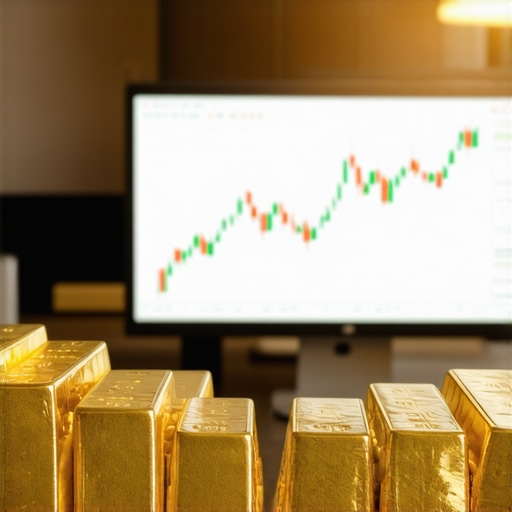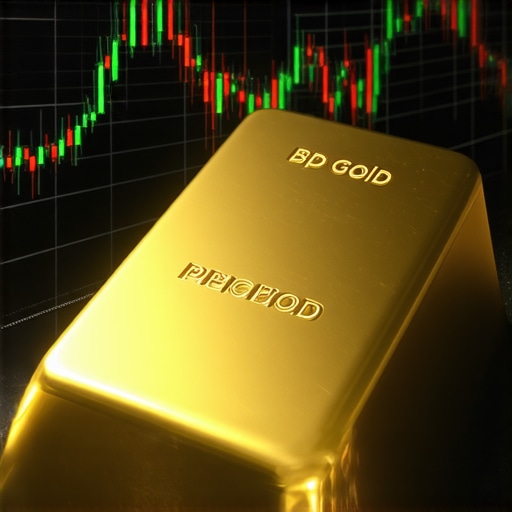Decoding the Future: Why 2025 Could Be a Pivotal Year for Gold Investors
As global economies grapple with inflationary pressures, geopolitical uncertainties, and shifting monetary policies, the spotlight intensifies on gold as a barometer for financial stability. The Gold Price Forecast 2025 is more than just a number; it embodies the complex interplay of demand, supply, and investor sentiment that savvy market participants must understand to navigate the evolving landscape. Exploring these dynamics offers profound insights that empower smart investing decisions in an era where traditional assets face volatility.
Unearthing Hidden Drivers: Supply Constraints and Central Bank Strategies
One cannot overlook the critical influence of gold supply limitations in shaping price trajectories. Mining output growth has plateaued in recent years due to geological and regulatory challenges, constraining new bullion availability. Meanwhile, central banks, notably from emerging economies, continue strategic gold acquisitions to diversify reserves and hedge against currency risks. This dual pressure—restricted supply juxtaposed with increasing official demand—creates a fertile ground for upward price momentum. For investors, understanding these supply-demand nuances is essential for timing entry and exit points effectively.
Investor Behavior and Market Sentiments: The Pulse of Gold Demand
Investor appetite for gold often surges in times of economic uncertainty, serving as a safe haven asset. The forecast for 2025 anticipates sustained interest driven by persistent inflation concerns and potential market corrections in equities and bonds. Moreover, technological advances in gold-backed financial instruments, such as ETFs and futures, facilitate easier access, broadening the investor base. Recognizing these behavioral trends can help investors align their portfolios with prevailing market currents and optimize returns.
How Do Global Economic Indicators Shape Gold Price Predictions for 2025?
Gold prices are intricately linked to macroeconomic indicators like inflation rates, interest rates, and currency strength. For instance, rising inflation usually boosts gold’s appeal as a hedge, while higher real interest rates can dampen its attractiveness by increasing opportunity costs. Currency fluctuations, especially the US dollar’s trajectory, significantly impact gold prices since the metal is dollar-denominated. Forecast models integrating these variables suggest gold could experience moderate to robust gains throughout 2025, contingent on how these indicators evolve amid geopolitical tensions and fiscal policies.
Strategic Approaches: Diversifying with Gold Stocks, ETFs, and Physical Assets
Smart investing in gold for 2025 involves more than just buying bullion. Diversification across gold stocks, ETFs, and physical gold can mitigate risk and capitalize on different market drivers. For example, gold mining stocks often amplify price movements and offer dividend potential, while ETFs provide liquidity and ease of trade. Physical gold, including coins and bars, remains a trusted store of value and inflation hedge. Learning to balance these exposures can enhance portfolio resilience and growth.Explore detailed expert insights on gold price forecasts for 2025 to deepen your investment strategy.
Trusting the Numbers: Leveraging Authoritative Forecasts for Informed Decisions
Consulting forecasts from reputable financial institutions and market analysts lends credibility and depth to investment planning. The World Gold Council, for example, regularly publishes comprehensive data and analysis on gold market fundamentals, offering investors a robust framework to anticipate price movements. Accessing such authoritative sources ensures your investment decisions rest on well-founded projections rather than speculative trends.
What’s your perspective on gold’s role in your 2025 investment portfolio? Share your thoughts or questions below to join an insightful community discussion on strategic gold investing.
Assessing Gold’s Role Amidst Evolving Global Monetary Policies
The landscape of global monetary policy is undergoing significant shifts, with central banks around the world adjusting interest rates and implementing unconventional measures in response to inflation and economic recovery post-pandemic. This fluid environment directly influences gold prices, as tighter monetary policies often strengthen fiat currencies and reduce gold’s appeal, whereas dovish stances tend to elevate gold demand. Investors must therefore stay vigilant to central bank announcements and macroeconomic policy changes to anticipate their impacts on gold markets effectively.
Moreover, the interplay between inflation targeting frameworks and gold’s traditional role as an inflation hedge becomes increasingly complex. While gold can protect purchasing power during high inflation periods, aggressive rate hikes aimed at curbing inflation might suppress gold prices temporarily. Navigating these nuances requires a deep understanding of how monetary policy cycles affect gold’s risk-reward profile.
Technological Innovations and Their Influence on Gold Trading and Accessibility
Technological advancements are reshaping how investors access and trade gold. The rise of digital platforms offering fractional ownership, blockchain-based gold tokens, and decentralized finance (DeFi) applications provide new avenues for participation with enhanced liquidity and transparency. These innovations lower entry barriers, especially for younger and tech-savvy investors, and introduce new market dynamics that could affect price volatility and trading volumes.
However, these emerging technologies also pose regulatory and security challenges that investors must consider. Ensuring compliance and safeguarding digital assets against cyber threats is paramount. Integrating traditional gold investment vehicles with innovative technologies can create a balanced and modern portfolio approach.
How Can Investors Integrate Gold Futures and Options into 2025 Portfolio Strategies?
Gold futures and options offer sophisticated tools for hedging and speculative positioning that can complement physical gold and equity holdings. Futures contracts allow investors to lock in prices, manage exposure to price fluctuations, and gain leverage, while options provide asymmetric risk profiles with limited downside. Employing these derivatives requires expertise in timing, market analysis, and risk management to maximize returns and minimize losses.
For example, strategic use of covered calls on gold ETFs or buying protective puts can enhance income or provide downside protection during volatile periods. Additionally, spreading positions across various maturities and strike prices can optimize risk-adjusted outcomes. Investors should acquire solid knowledge or consult experts before incorporating these instruments into their portfolios.
Environmental, Social, and Governance (ESG) Factors in Gold Mining Investments
Increasingly, ESG considerations are shaping gold investment decisions, particularly in mining stocks and funds. Mining companies with strong ESG credentials often exhibit better operational efficiency, lower regulatory risks, and improved community relations, which can translate into more stable financial performance and long-term value creation.
Investors are advised to evaluate mining companies’ environmental impact, labor practices, and governance structures as part of their due diligence. This approach not only aligns with ethical investing but may also mitigate risks associated with environmental regulations and social license to operate, which are critical for sustainable returns in the gold sector.
For further exploration of gold stock investments aligned with ESG principles, see top gold mining stocks with profitable growth potential in 2025.
Authoritative Gold Market Insights: Leveraging Data for Strategic Advantage
Staying informed with credible market analysis is vital for successful gold investment. The World Gold Council offers extensive reports and data on supply-demand fundamentals, central bank activity, and investment trends that serve as a trusted foundation for decision-making. Their comprehensive statistical releases and expert commentaries help investors contextualize market movements within broader economic frameworks.
In addition, financial news outlets like Bloomberg and Reuters provide timely updates and expert opinions that complement foundational research. Combining these sources enables investors to form nuanced views and anticipate market shifts with greater precision.
According to the World Gold Council’s latest research, global gold demand is expected to remain robust in 2025, supported by continued central bank purchases and steady investment demand despite challenges in jewelry consumption and industrial usage (World Gold Council, 2024). This multifaceted demand outlook underscores the importance of diversified investment approaches.
What advanced strategies are you considering for your gold investments in 2025? Share your insights or questions below to engage with a community of experienced investors focused on maximizing gold portfolio performance.
Mastering Gold Derivatives: Unlocking Sophisticated Hedging and Leveraging Strategies
For investors aiming to elevate their gold portfolio strategies in 2025, incorporating derivatives such as futures, options, and swaps presents a compelling avenue to manage risk and amplify returns. Gold futures contracts enable locking in prices ahead of time, effectively hedging against adverse price movements or capitalizing on anticipated trends. Meanwhile, options provide the flexibility to benefit from upside potential while capping downside risk, making them invaluable tools for volatility management.
Implementing strategies like calendar spreads, straddles, or protective puts requires a nuanced understanding of market timing, implied volatility, and macroeconomic catalysts. For instance, a calendar spread can exploit differences in futures contract prices across maturities, while a straddle anticipates significant price swings without directional bias. Leveraging these complex instruments can offer asymmetric payoffs that traditional physical gold holdings cannot deliver.
Can integrating gold derivatives improve portfolio resilience during unpredictable market cycles?
Indeed, the strategic use of gold derivatives can enhance portfolio resilience by providing tailored exposure and hedging capabilities. During periods of heightened uncertainty or inflationary spikes, derivatives allow investors to adjust their risk profiles dynamically without liquidating core physical or equity positions. This adaptability is crucial when monetary policies shift abruptly or geopolitical risks escalate, as it enables rapid repositioning aligned with evolving market conditions.
However, it is essential to combine derivatives usage with robust risk management protocols, including position sizing, stop-loss orders, and continuous market monitoring. Engaging with seasoned financial advisors or leveraging algorithmic tools can further optimize derivative deployment and minimize unintended exposures.
ESG Metrics in Gold Mining: Navigating Sustainable Investment Amid Complex Supply Chains
Environmental, Social, and Governance (ESG) criteria have transcended from niche considerations to central pillars in gold investment analysis. Leading mining companies now adopt advanced sustainability frameworks, emphasizing carbon footprint reduction, water conservation, and ethical labor practices. These initiatives not only mitigate environmental risks but also fortify community relations, which are vital for uninterrupted operations.
Governance structures emphasizing transparency, anti-corruption measures, and stakeholder engagement enhance investor confidence and reduce systemic risks. Importantly, ESG-compliant gold mining firms often exhibit superior operational efficiencies, lower cost structures, and improved access to capital markets, translating into long-term shareholder value.
Assessing ESG performance requires access to granular data and third-party verifications, such as those provided by the Sustainalytics platform or the MSCI ESG Ratings. Investors incorporating these metrics can better anticipate regulatory shifts and reputational risks that impact gold supply chains and valuations.
Integrating Macro-Financial Models with Geopolitical Risk Assessments for Enhanced Gold Price Forecasting
Beyond traditional economic indicators, cutting-edge gold price forecasting models now integrate geopolitical risk indices, commodity market interdependencies, and sentiment analytics derived from big data. These multipronged approaches enable more accurate scenario planning and stress testing of portfolios against complex global events such as trade wars, sanctions, and regional conflicts.
For example, Bayesian networks and machine learning algorithms synthesize diverse datasets—ranging from central bank asset purchases to energy price shocks—to dynamically recalibrate gold price trajectories. This fusion of quantitative rigor with qualitative geopolitical insights empowers investors to anticipate inflection points more precisely than conventional methods.
Staying abreast of such sophisticated forecasting techniques requires continuous education and access to platforms specializing in alternative data analytics, such as Refinitiv or Bloomberg Quantamental Research. Incorporating these insights into investment decision-making elevates portfolio robustness amid the unpredictability of 2025’s macroeconomic landscape.
Ready to refine your gold investment approach with advanced derivatives, ESG integration, and cutting-edge forecasting? Dive deeper into expert analyses and strategies to position your portfolio for the complexities ahead.
Innovative Technological Frontiers Transforming Gold Investment Dynamics
As digital transformation accelerates, the gold market is witnessing paradigm shifts driven by blockchain-enabled tokenization, fractional ownership platforms, and decentralized finance (DeFi) protocols. These innovations democratize access to gold investment, allowing smaller investors to participate with unprecedented liquidity and transparency. However, navigating the regulatory labyrinth and cybersecurity risks remains a formidable challenge that requires sophisticated due diligence and risk mitigation strategies.
Integrating these technological advancements with traditional gold portfolios can enhance diversification and adaptability, positioning investors to capitalize on evolving market structures. The convergence of digital assets and precious metals is redefining liquidity paradigms and offering novel hedging opportunities, particularly in volatile macroeconomic conditions.
What Are the Best Practices for Incorporating Gold Derivatives to Optimize Risk-Adjusted Returns in 2025?
Expert investors increasingly turn to derivatives such as futures, options, and swaps to fine-tune exposure and hedge against market uncertainty. Employing strategies like calendar spreads and protective puts enables precise risk control and capitalizes on volatility without liquidating core holdings. The key lies in meticulous timing, understanding implied volatility dynamics, and rigorous risk management frameworks. For instance, layered option positions can create asymmetric payoffs that protect downside risk while preserving upside potential, essential in the anticipated turbulent markets of 2025.
ESG Integration: Elevating Gold Mining Investments Through Sustainable Governance
Incorporating Environmental, Social, and Governance (ESG) metrics into gold mining investment analysis has transitioned from ethical preference to a critical value driver. Companies demonstrating robust ESG practices tend to exhibit enhanced operational efficiencies, reduced litigation risks, and stronger stakeholder engagement, culminating in improved long-term financial performance. Investors leveraging ESG data platforms like Sustainalytics and MSCI ESG Ratings can discern nuanced risk exposures and identify opportunities within the sustainable gold mining landscape.
Synergizing Macroeconomic Models with Geopolitical Risk Analytics for Superior Forecasting Precision
State-of-the-art forecasting now encompasses multidisciplinary approaches, weaving macro-financial models with geopolitical risk assessments and sentiment analytics derived from artificial intelligence. Platforms such as Refinitiv and Bloomberg Quantamental Research exemplify tools that synthesize diverse data streams—ranging from central bank asset movements to commodity price shocks—to dynamically recalibrate gold price trajectories. This fusion empowers investors to anticipate inflection points with enhanced accuracy and tailor strategies responsive to complex global events.

Engage with the Cutting Edge: Elevate Your Gold Investment Strategy Today
Harnessing advanced derivatives, ESG insights, and sophisticated forecasting methodologies can dramatically enhance portfolio resilience and performance in 2025’s intricate market environment. We invite seasoned investors and market enthusiasts alike to explore these nuanced facets and integrate them into their strategic frameworks.
Ready to transform your gold investment approach with deep expertise and innovative tools? Connect with our expert analysts and access tailored insights to optimize your portfolio’s potential.
Frequently Asked Questions (FAQ)
What key factors will most influence gold prices in 2025?
Gold prices in 2025 will be primarily influenced by inflation trends, central bank monetary policies, geopolitical tensions, supply constraints in mining, and investor demand shifts. Inflationary pressures tend to increase gold’s appeal as a hedge, whereas tighter monetary policies and stronger fiat currencies may suppress prices. Additionally, limited new gold supply and rising central bank purchases create upward pressure. Understanding how these drivers interact is crucial for accurate forecasting and strategic investing.
How can investors best diversify their gold holdings in 2025?
Effective diversification involves allocating capital across physical gold (coins and bars), gold mining stocks, exchange-traded funds (ETFs), and derivatives such as futures and options. Physical gold offers a tangible store of value, mining stocks provide leverage to gold price movements plus dividends, ETFs ensure liquidity and ease of trading, while derivatives allow sophisticated hedging and speculative strategies. Balancing these exposures helps manage risk and capture multiple return streams.
What role do ESG considerations play in gold mining investments?
Environmental, Social, and Governance (ESG) factors increasingly impact gold mining investments by influencing company sustainability, regulatory compliance, and social license to operate. Mining firms with strong ESG performance tend to have better operational efficiency, lower risks, and enhanced investor confidence, leading to potentially superior long-term returns. Investors should evaluate mining companies’ ESG metrics using trusted platforms like Sustainalytics and MSCI ESG Ratings to align investments with ethical principles and mitigate risks.
How are technological innovations reshaping gold investment accessibility?
Technological advances such as blockchain-based gold tokenization, fractional ownership platforms, and decentralized finance (DeFi) protocols are democratizing access to gold investments. These innovations reduce entry barriers, enhance liquidity, and increase transparency, especially for smaller or tech-savvy investors. However, they also introduce regulatory uncertainties and cybersecurity risks, necessitating careful due diligence. Integrating digital assets with traditional gold holdings can create a modern, diversified portfolio.
Can gold derivatives improve portfolio resilience in volatile markets?
Yes, derivatives like futures and options provide tools for risk management and strategic positioning. They enable investors to hedge against adverse price movements, capitalize on volatility, and tailor exposure with asymmetric risk profiles. Proper use of strategies such as calendar spreads, protective puts, and covered calls can enhance returns and protect downside risk. However, derivatives require expertise and disciplined risk management to avoid amplified losses.
How do global economic indicators influence gold price forecasts?
Macroeconomic indicators such as inflation rates, real interest rates, and US dollar strength critically shape gold price movements. Rising inflation and low or negative real interest rates typically increase gold’s attractiveness as an inflation hedge, while a stronger dollar often exerts downward pressure on gold prices. Forecast models integrating these variables alongside geopolitical risk assessments improve predictive accuracy for 2025 market conditions.
What advanced forecasting methods are used to predict gold prices?
Cutting-edge forecasting combines macro-financial models with geopolitical risk analytics and big data sentiment analysis, often employing machine learning and Bayesian networks. These methods synthesize diverse data—from central bank actions to commodity price shocks—to dynamically recalibrate price projections. Access to platforms like Refinitiv and Bloomberg Quantamental Research enables investors to anticipate market inflections with greater precision than traditional models.
How should investors approach gold investment amid shifting global monetary policies?
Investors must monitor central bank decisions closely, as tightening monetary policy and rising interest rates can dampen gold demand, while dovish policies and inflation fears typically boost it. Understanding the timing and magnitude of policy shifts helps investors adjust exposure proactively. Combining physical holdings with derivatives and diversified instruments can provide flexibility to navigate changing policy landscapes.
What risks accompany investing in gold through technological platforms?
While digital platforms enhance accessibility, they also pose risks including regulatory uncertainty, potential fraud, cybersecurity vulnerabilities, and liquidity constraints. Investors should conduct thorough due diligence, verify platform credibility, understand legal frameworks, and employ security best practices. Balancing innovative digital investments with established traditional vehicles mitigates these risks.
How can investors integrate ESG metrics effectively when selecting gold mining stocks?
Effective ESG integration involves analyzing third-party ratings, reviewing company sustainability reports, and assessing environmental impact, labor relations, governance transparency, and community engagement. Investors should prioritize firms demonstrating measurable ESG improvements and transparent disclosures. This approach reduces exposure to regulatory penalties and reputational damage, supporting sustainable financial performance.
Trusted External Sources
- World Gold Council: The premier authority on gold market fundamentals, providing comprehensive data on supply-demand dynamics, investment trends, and central bank activities vital for informed forecasting and strategy development.
- Bloomberg Professional Services: Offers real-time financial data, expert analyses, and quantitative research tools, including Bloomberg Quantamental Research, essential for advanced modeling and market sentiment insights.
- Refinitiv (formerly Thomson Reuters): Provides extensive macroeconomic and geopolitical datasets, big data analytics, and sentiment indicators that enrich gold price forecasting with multidimensional perspectives.
- Sustainalytics: A leading ESG research and ratings platform delivering granular assessments of environmental, social, and governance performance of gold mining companies, supporting sustainable investment decisions.
- MSCI ESG Ratings: Offers robust ESG scoring methodologies and data that help investors evaluate mining firms’ sustainability risks and opportunities, facilitating ethical and risk-conscious portfolio construction.
Conclusion
As 2025 approaches, the gold market presents a complex yet promising landscape shaped by intertwined economic, geopolitical, technological, and sustainability factors. Understanding the multifaceted drivers—from inflationary trends and central bank maneuvers to ESG imperatives and digital innovations—is imperative for crafting resilient and growth-oriented gold investment strategies. Diversifying across physical assets, equities, ETFs, and derivatives, while leveraging advanced forecasting and ESG analytics, equips investors to navigate volatility and capitalize on emerging opportunities. Embracing this expert-informed approach not only enhances portfolio robustness but also aligns investments with the evolving dynamics of global markets. Engage actively with these insights, share your perspectives, and explore further expert analyses to refine your gold investment strategy for a successful 2025 and beyond.










This is a comprehensive and well-structured analysis of the factors influencing gold in 2025. I particularly find the discussion on technological innovations and digital platforms intriguing, as I’ve seen many younger investors become more interested in gold via blockchain tokens and fractional ownership. It’s a game-changer for liquidity and accessibility.
However, I wonder how these digital advancements will impact traditional gold prices and market stability, especially considering regulatory uncertainties. Has anyone come across reliable ways to assess the security and credibility of these digital platforms? I’d love to hear practical tips on integrating these new tech-driven assets into a balanced, long-term portfolio while managing cybersecurity risks effectively.